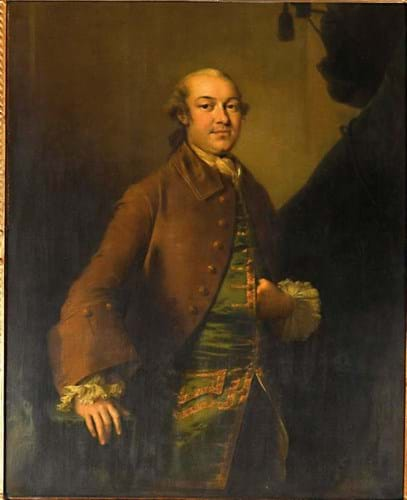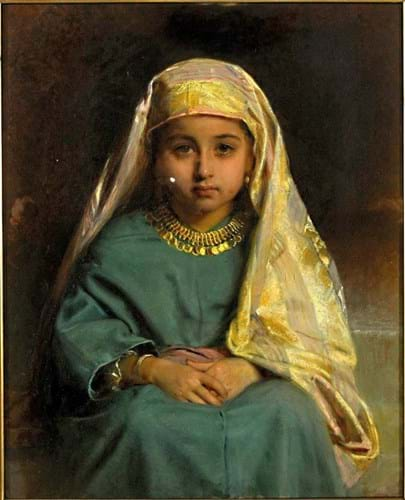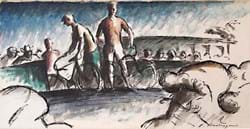
When a picture has some superficial or minor flaws but is in a decent underlying state there is no reason – given the skills of modern conservation – that it should not attract significant interest, especially when offered with a sensible estimate.
A few such ‘treatable’ examples came up at the latest specialist picture sale at Lawrences (25% buyer’s premium) of Crewkerne on July 21.
In particular, a pair of 18th century portraits caught the eye of both trade and private bidders even though they were rather dirty with a yellowed and, in some places, slightly frosted varnish.
The painting of the London brewer George Hodgson and the separate double-portrait of his wife and child by Thomas Frye (1710-62) came with old linings and rather taut canvases but, crucially, there were no signs of damage or apparent repairs. The craquelure was consistent with age, with no lifting or cupping, and under UV light only scattered retouching was apparent.
The auction house believed they would clean extremely well and the market seemed to agree that a little restoration would yield rewards.
Dating from 1758, the subject of the portraits raised them from the pack too.
Hodgson founded his family brewery at Bromley-by-Bow in 1752 and grew rapidly to dominate the lucrative export market of supplying beer to British expats in India. The East India Company’s London offices were barely a few miles away and the conglomerate benefited from Hodgson’s amenable 18-month credit terms. This enabled the vessels to return to London with valuable treasures from Asia before having to settle Hodgson’s invoice.
The initial orders of porter (strong dark beer) did not travel well and so Hodgson developed a lighter brew, known as ‘barleywine’ or ‘October beer’ as it was brewed later in the season. Hodgson’s India Ale, once thought incorrectly to be the very first IPA (India Pale Ale), became a familiar and popular brand.
The portraits at Lawrences were both 4ft 1in x 3ft (1.25 x 1m) oils on canvas. While works by Frye on this scale are relatively scarce, they were characteristic of his highly competent style in terms of composition, colour and technique.
The Anglo-Irish artist, who was also one of the founders of the Bow porcelain factory, is sometimes more admired for his ‘character study’ prints than his larger painted portraits – such as his famous ‘Ladies’ series and his striking mezzotint self-portrait head study (almost life size) from 1760. His formal portraits, such as this pair for which he no doubt received a handsome commission, have sometimes been judged to be a bit flat and having a slightly staid format.

One of a pair of portraits by Thomas Frye depicting the brewer George Hodgson and his wife, Elizabeth with their daughter (shown here). Offered together, they sold for £30,000 at Lawrences of Crewkerne.
These examples, though, showing Hodgson wearing a russet coat and brocaded green waistcoat and his wife in a satin dress with rosettes and a blue ribboned bodice, promised to reveal some distinct colouring as part of the cleaning process which could lift the whole work and bring the characters to life.
Along with the good provenance (they had descended in the family of the sitters), this engendered plenty of interest against a £15,000-20,000 estimate including from ‘discerning collectors’, according to Lawrences. After a decent competition on the day, the lot was knocked down at £30,000 to a buyer from Ireland.
The price was the second-highest recorded auction price for Frye’s work, only behind another pair of portraits of an unknown gentleman and lady that took £35,000 at Sotheby’s in April 2010.
It was also the top price of the Lawrences sale.
Warm atmosphere
An Italianate landscape by Austrian painter Franz de Paula Ferg (1689-1740) was another work not in perfect condition but found appeal among buyers.
It had previously been part of the collection at Fawley Court, Henley-on-Thames, and had descended to the West Country vendor.
The 2ft 6in x 3ft 8in (75cm x 1.11m) oil on canvas had been relined in the 1970s and had some scattered retouching but the surface was secure with only some craquelure consistent with age.
It did have one area of retouching towards the lower right corner that was thought may have been applied as part of restoration work to a small tear carried out about 30 years ago, but no obvious signs of any significant damage were evident.
With the condition not distracting from the warm atmosphere of the composition depicting countryfolk and livestock in a sunlit river landscape, the picture drew decent interest against a £6000-8000 estimate and sold at £9500.
Works by the prolific artist, who was also known as Francis Paul Ferg, can make a wide range of prices. This result represented a good mid-range sum when it sold to a private buyer from Yorkshire, underbid by a private buyer in Kent.
Academy exhibit
Meanwhile a 19th century picture at the sale that benefited from being in excellent original condition was Zehra by John Bagnold Burgess (1829-97).
A Royal Academy exhibit from 1880, it had been part of a longstanding family collection in Yorkshire having seemingly been bought from the RA show by an ancestor.
Consigned here from a Somerset vendor who had inherited it, the 2ft 5in x 23in (73 x 59cm) oil on canvas had been kept under glass and had apparently never been removed from its original frame. With no retouching visible under UV light, it was pitched at £3000-4000.
The artist, who specialised in interior genre scenes, produced a good number of Eastern scenes, most of which were generic pictures (although he is known to have visited north Africa at least once). He also produced many Spanish subjects which are among his most commercial works.
While Zehra is an Arabic name (meaning brilliant, bright, shining), Lawences’ picture specialist Richard Kay thought it was unlikely to have been painted from life. Nevertheless, the estimate was not deemed excessive and keen enquiries emerged from both UK trade and private buyers.
After good competition, it was eventually sold for £13,000 to a private collector in Berkshire – a sum that stands in the top 10 auction prices for the artist (source: Artprice by Artmarket).
















